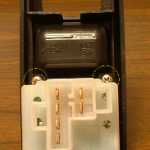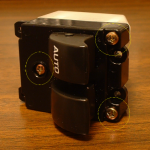Author: Jonathan Swain (aka "PurdueGuy")
Intro
Unfortunately a lot of the photos for this guide corrupted and have been lost. Hopefully someday I can re-create them or find good copies. Sorry.
Ok, this is a problem that I had with my car, and I’ve seen the problem on another Saturn, so I figure it’s probably not uncommon. When the trouble with my power window switch first became evident, it was when I couldn’t get the passenger side window up on my ’99 SC1. After dismantling much of the door, my wife suggested that I check the switch. Like any wise man, I considered the advice of my wife and decided to check the switch. It was the problem.
The trouble is that the switch that you actually touch moves a plastic post with a spring, which moves a see-saw like metal piece, which sometimes does not make good contact like it is supposed to. Over time this can build up charring on the contacts, and eventually make the switch work intermittently or not at all. Also, as in my case, heat can build up and melt part of your switch. Pictures of this problem to come…
*Note that first and third gen switches are similar, but not exactly the same. You can likely apply lessons learned here to figure out repairs for the other generations.
Relevant Models
All 1995 – 1999 S-Series with power windows
Tools
Ratchet
7mm socket
Parts
If anyone needs parts for inside the switch, like I did, note that you don’t have to find a switch to match your car. My part came from an SL. The SL’s have the same parts inside the switch as the SC’s – there are just more of the 2-peg posts. You can rob parts from an SL switch to put in an SC switch, and vise-versa. It just needs to be from the same style interior.
Repair
Step 1
Step 2
Now your switch assembly is removed and you can take it wherever is easiest to work on it. Someplace where you won’t lose small parts is recommended.
This is what the switch should look like, approximately, on an SC. The SL/SW switch is similar in design, and the interior parts are extremely similar – there’s just more of them, plus a lockout switch.
Step 4
The switch should now come right out from the switch panel, and will look like this. (On a side note, this is a good time to clean up your switches and get the stuff that the last owner dropped into them.) Now you are ready to take the top, with the finger switches, off of the rest of the switch assembly. To do so, use your Phillips again on these 3 screws:
Step 5
Now the finger switches and the plate they mount to will lift up off the rest of the switch assembly. There are some pieces in here that are not held down, so be sure to keep track of them. They are often somewhat held in place by small amounts of jelly, but they may still fall out. This is what the switch will now look like without the finger switches, and with the two loose pieces removed. You can see the small amount of charring that had built in the 2 weeks or so between when I cleaned the contacts and when I fixed the melted piece (discussed later):
These are the toggle switches. (Note that the express down window does not have these toggles, but a slider. I have not gotten further into the switch to look at how the express window switch is designed.) You may very well see black charring around both ends of these toggle switches. This appears to be a self-perpetuating problem – once the switch chars a little, it is even harder to make contact, and it chars some more.
This may be as far as you will need to dismantle your switch. Use some electrical contact cleaner and clean that puppy right up! If you have had trouble with your power window not working from time to time, this *may* solve the problem.
I do encourage everyone to read further, however, because the occurrence of charring may have caused another problem, which happened to me. Heat may have caused some damage, which I will show in a few pictures.
Step 6
Next we will take apart the finger switch assembly. There is a small metal pin running through each of the finger switches. Look at each end of this pin. One end has a head, the other doesn’t. Push in on the end without the head, then grab the head end and pull the pin out.
Step 7
At this point, the parts should practically fall apart. In a 2-window switch, there will be 6 parts – the 2 finger switches, a white post from each finger switch, the switch base, and the pin.
Notice that the white posts are different. The one for the express window has a single peg sticking down. Posts for regular windows have 2 smaller pegs sticking down. The pegs on the regular window white posts push on those metal rocker switches.
This was where my ultimate problem was. The heat that was created along with the charring had melted one of the pegs on my passenger window post piece. This meant it could not push the rocker switch all the way to make good contact, and the poor contact caused the problem with the charring all over again.
Below is a pic of the post with the melting (on the left), and the post I got from a junkyard to fix the switch with (on the right).
You’ll want to examine your posts and see if any melting like this has occurred. If not, great, just clean up the switch with contact cleaner.
Installation
Assembly is the reverse of disassembly. All the parts are keyed so they shouldn’t be able to be put in wrong. Take your time, and it will go together just fine.
One note: when you place the finger switches (on the base) back on the lower switch assembly, make sure the express window switch peg fits in the slide for it on the lower switch assembly. If you don’t get it in there, it will be evident immediately, and you will just have to take the switch apart again and try again.


